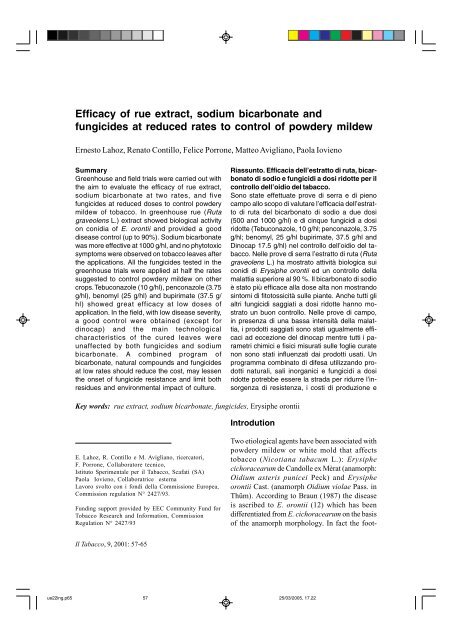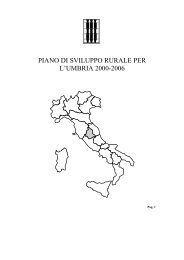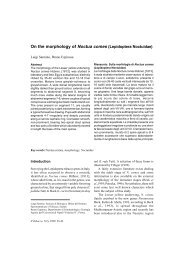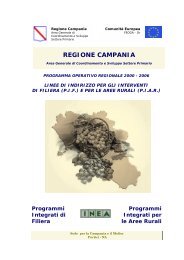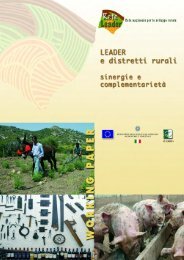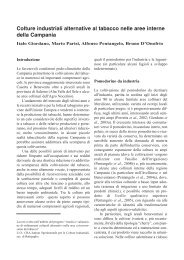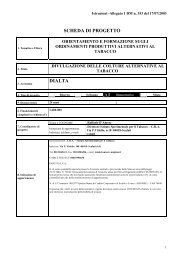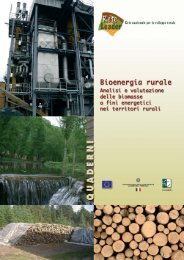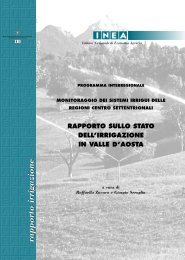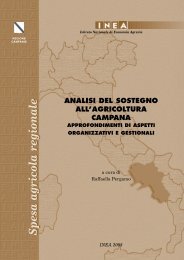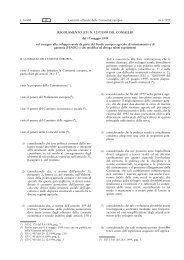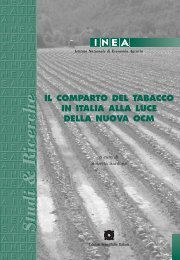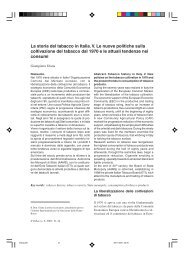Efficacy of rue extract, sodium bicarbonate and fungicides at ... - Inea
Efficacy of rue extract, sodium bicarbonate and fungicides at ... - Inea
Efficacy of rue extract, sodium bicarbonate and fungicides at ... - Inea
Create successful ePaper yourself
Turn your PDF publications into a flip-book with our unique Google optimized e-Paper software.
58Il Tabacco, 9industries <strong>and</strong> have broad-spectrum antimicrobialactivity. Moreover, they have been tested forcontrolling powdery mildew on several plantspecies (1,6,9,10,16).The objective <strong>of</strong> this study is to evalu<strong>at</strong>e theefficacy <strong>of</strong> <strong>rue</strong> <strong>extract</strong>, <strong>sodium</strong> <strong>bicarbon<strong>at</strong>e</strong> <strong>and</strong>five <strong>fungicides</strong> <strong>at</strong> low r<strong>at</strong>es in greenhouse <strong>and</strong>field trials to control E. orontii on tobacco plants.M<strong>at</strong>erials <strong>and</strong> MethodsFigure 1 - Conidiophores <strong>and</strong> conidia <strong>of</strong> Erysipheorontii.Fig. 1. Conidi<strong>of</strong>ori e conidi di Erysiphe orontii.cells <strong>of</strong> the conidiophores <strong>and</strong> the conidia chainsare curved <strong>and</strong> with cren<strong>at</strong>e edges in E. orontii(Fig. 1), while they are erect with sinu<strong>at</strong>e edgesin E. cichoracearum (Fig. 2). Plotnikova et al.,(1998) identified E. orontii as the agent <strong>of</strong>powdery mildew even on Arabidopsis thaliana,where E. cichoracearum <strong>and</strong> E. cruciferarum hadbeen previously reported. Erysiphe isol<strong>at</strong>esrecovered from Italian tobacco crops correspondto the E. orontii description.Powdery mildew has spread to most countrieswhere tobacco is cropped, <strong>of</strong>ten occurring as adisease <strong>of</strong> major importance. When resistantcultivars are not available, fungicide applic<strong>at</strong>ionsare necessary to avoid yield losses, neverthelessthe reduction <strong>of</strong> agrochemicals use is one <strong>of</strong> themajor objectives to be achieved in Europeantobacco growing areas. N<strong>at</strong>ural products,inorganic salts <strong>and</strong>/or <strong>fungicides</strong> <strong>at</strong> lower r<strong>at</strong>esthan those used on other crops, may limit bothresidues on cured tobacco leaves <strong>and</strong> theenvironmental impact <strong>of</strong> the crop. Biologicallyactive n<strong>at</strong>ural products (allelochemicals)isol<strong>at</strong>ed from higher plants are now beingemployed as <strong>fungicides</strong> <strong>and</strong> in biocontrol <strong>of</strong>plant diseases (8,14).Oliva et al. (1999) demonstr<strong>at</strong>ed significantin vitro fungist<strong>at</strong>ic activity <strong>of</strong> <strong>rue</strong> (Rutagraveolens L.) <strong>extract</strong> against six fungal species.Bicarbon<strong>at</strong>e salts are widely used in the foodFungal isol<strong>at</strong>e <strong>and</strong> inocul<strong>at</strong>ion: Plants withsymptoms <strong>of</strong> powdery mildew were harvested ina farm loc<strong>at</strong>ed in a typical «burley» tobaccogrowing area (Caserta) <strong>of</strong> southern Italy. Conidiafrom those plants were collected, then inocul<strong>at</strong>edon 2 month old plants using a suspension adjustedto 10-20 conidia/ml with the aid <strong>of</strong> anhemacytometer in 0.1% sterile w<strong>at</strong>er agar (SWA)to allow the development <strong>of</strong> spare colonies (Fig.3). At theoutbreak <strong>of</strong>symptoms,conidia from asingle spotwere re-inocul<strong>at</strong>edon theleaves <strong>of</strong> healthyplants. Thisprocedure wasrepe<strong>at</strong>ed until20 plants werewell colonizedas a source <strong>of</strong>inoculum forthe greenhousetest.Suspensionconcentr<strong>at</strong>ionused for testingactive ingredientswas 10 5conidia/ml <strong>and</strong>10 ml/plantwas appliedusing a labo-Figure 2 - Conidiophores <strong>and</strong>conidia <strong>of</strong> Erisiphae cichoracearum.Fig. 2. Conidi<strong>of</strong>ori e conidi diErisiphae cichoracearum.ue22ing.p65 5825/03/2005, 17.22
Lahoz et al. Efficacia dell’estr<strong>at</strong>to di ruta, bicarbon<strong>at</strong>o e....... 59r<strong>at</strong>ory sprayer (Fig. 3). The inocul<strong>at</strong>ion was made1 day after the first applic<strong>at</strong>ion <strong>of</strong> the <strong>rue</strong> <strong>extract</strong>,<strong>sodium</strong> <strong>bicarbon<strong>at</strong>e</strong> <strong>and</strong> <strong>fungicides</strong>.Greenhouse testing <strong>of</strong> active ingredients. Twotrials (A <strong>and</strong> B), planned as r<strong>and</strong>om completeblock design (RCBD) with four replic<strong>at</strong>es, werecarried out <strong>at</strong> Tobacco Experimental Institute in1997 <strong>and</strong> 1998. Plants <strong>of</strong> S2/95 cultivar, whichis highly susceptible to Erysiphe orontii, weretransplanted in 35 cm plastic pots (1 plant/pot)after 30 days from sowing; tre<strong>at</strong>ments wereapplied to all leaves on 10, 3-month-old, plants<strong>of</strong> each replic<strong>at</strong>e. Temper<strong>at</strong>ure in the greenhousewas 22 ± 2°C with continuous illumin<strong>at</strong>ion toallow sporul<strong>at</strong>ion (7) <strong>and</strong> 75 ± 10% rel<strong>at</strong>ivehumidity. Rue <strong>extract</strong>, <strong>sodium</strong> <strong>bicarbon<strong>at</strong>e</strong> <strong>and</strong>five <strong>fungicides</strong> (Penconazole 10EC;Tebuconazole 25 WG; Benomyl 50WP; Dinocap25WP; Bupirim<strong>at</strong>e 25 EC) <strong>at</strong> low r<strong>at</strong>e <strong>of</strong>applic<strong>at</strong>ion were compared. All tre<strong>at</strong>ments wereapplied with a labor<strong>at</strong>ory h<strong>and</strong> sprayer to run <strong>of</strong>f.R<strong>at</strong>es, intervals <strong>and</strong> number <strong>of</strong> applic<strong>at</strong>ions foreach tre<strong>at</strong>ment are reported in Table 1.Phytotoxicity was evalu<strong>at</strong>ed using anempirical scale with values ranging from 1 (nophytotoxicity) to 9 (plant de<strong>at</strong>h).Disease severity (DS) was assessed using twomethods: a) starting from the outbreak <strong>of</strong>symptoms, the number <strong>of</strong> sporul<strong>at</strong>ing mildewcolonies on 8 basal leaves for each <strong>of</strong> 10 plants/replic<strong>at</strong>e was recorded every 8 days; b) the leafarea covered with powdery mildew symptomswas evalu<strong>at</strong>ed 8 days after the last applic<strong>at</strong>ion,then percentage <strong>of</strong> disease control was calcul<strong>at</strong>ed.Field trialTwo field trials planned as completely r<strong>and</strong>omizedblock design with 4 replic<strong>at</strong>es were carried out in1997 <strong>and</strong> 1998. Plants <strong>of</strong> cultivar S2/95 weretransplanted <strong>at</strong> 20/5 <strong>and</strong> 15/5 respectively for thetwo trials. Applic<strong>at</strong>ions <strong>of</strong> the <strong>fungicides</strong> (the sameforeseen in the greenhouse test) started from thefirst ten days <strong>of</strong> July. The influence <strong>of</strong> the tre<strong>at</strong>mentson the technological characteristics <strong>and</strong> on theefficacy were evalu<strong>at</strong>ed. Disease severity wasevalu<strong>at</strong>ed using Coresta scale ranging from 0 (nosymptoms) to 5 (> 50 % <strong>of</strong> leaf surface covered bythe fungus).Figure 3 – Leaves <strong>of</strong> inocul<strong>at</strong>ed tobacco plantsshowing spare colonies (top) <strong>and</strong> leaves inocul<strong>at</strong>edwith a higher concentr<strong>at</strong>ion <strong>of</strong> conidia <strong>of</strong> Erysipheorontii.Fig. 3. Foglie di tabacco inocul<strong>at</strong>e mostranti rare colonie(in alto) e foglie inocul<strong>at</strong>e con elev<strong>at</strong>e concentrazionidi conidi di Erysiphe orontii.Rue <strong>extract</strong> prepar<strong>at</strong>ion. Fresh leaves <strong>of</strong> R.graveolens were collected from plants grown <strong>at</strong>the Tobacco Research Institute in Scaf<strong>at</strong>i, Italy.250 g <strong>of</strong> fresh leaf m<strong>at</strong>erial were soaked in 1 literdeionized w<strong>at</strong>er <strong>at</strong> 90 °C for 10 min, followedby filtr<strong>at</strong>ion through Wh<strong>at</strong>man No. 1 filter paper(17). The filtr<strong>at</strong>e was lyophilized, yielding 10 g/l <strong>of</strong> powdered <strong>extract</strong>.Microscopic examin<strong>at</strong>ion <strong>of</strong> conidia. Fourplants were inocul<strong>at</strong>ed with 10 ml (10 5 conidia/ml) <strong>of</strong> E. orontii conidial suspension, two <strong>of</strong> themwere then tre<strong>at</strong>ed with <strong>rue</strong> <strong>extract</strong> <strong>and</strong> two withsterile distilled w<strong>at</strong>er (SDW). 24 h after theue22ing.p65 5925/03/2005, 17.22
Lahoz et al. Efficacia dell’estr<strong>at</strong>to di ruta, bicarbon<strong>at</strong>o e....... 61Figure 4 – Leaves <strong>of</strong> untre<strong>at</strong>ed control plants <strong>at</strong> theend <strong>of</strong> the trial showing severe powdery mildewsymptoms.Fig. 4.Foglie del controllo non tr<strong>at</strong>t<strong>at</strong>o alla fine dellaprova con gravi sintomi di oidio.ResultsThe coloniz<strong>at</strong>ion <strong>of</strong> the untre<strong>at</strong>ed tobacco leaveswas complete 30 days after the inocul<strong>at</strong>ion, l<strong>at</strong>eron spots became necrotic <strong>and</strong> basal leaves died.Inocul<strong>at</strong>ion methods using 10 5 conidia /mlsuspended in 0.1% SWA showed constant <strong>and</strong>reproducible results.Greenhouse testing <strong>of</strong> active ingredients. Nophytotoxicity was observed on plants for anycompound tested in the trials (Table 2).Rue <strong>extract</strong> was very effective forcontrolling powdery mildew in both trials.Sodium <strong>bicarbon<strong>at</strong>e</strong> <strong>at</strong> 500 g/hl reduced diseaseover control, even if, in trial A, more than 9spots/leaf were observed, 8 days after the lastapplic<strong>at</strong>ion. Penconazole, tebuconazole <strong>and</strong>benomyl completely controlled diseasedevelopment (Table 2). On untre<strong>at</strong>ed controlplants were counted over 24 <strong>and</strong> 20 coloniesper leaf respectively in trial A <strong>and</strong> B,equivalent <strong>of</strong> about 60% damaged leaf surface(Fig.4), indic<strong>at</strong>ing th<strong>at</strong> the disease pressure washigh.An increased disease severity was observedafter repe<strong>at</strong>ed applic<strong>at</strong>ions <strong>of</strong> <strong>sodium</strong><strong>bicarbon<strong>at</strong>e</strong> <strong>at</strong> 500 g/hl, while its efficacy washigher <strong>at</strong> 1000 g/hl, <strong>and</strong> a most s<strong>at</strong>isfactorycontrol was reached after three applic<strong>at</strong>ions.On benomyl tre<strong>at</strong>ed plants, less than 1sporul<strong>at</strong>ing spot per leaf was observed, startingfrom the second applic<strong>at</strong>ions. Bupirim<strong>at</strong>ereduced disease severity to a level equivalentto th<strong>at</strong> <strong>at</strong>tained with <strong>rue</strong> <strong>extract</strong>, requiring twoapplic<strong>at</strong>ions to obtain its maximumeffectiveness. A trend similar to <strong>sodium</strong><strong>bicarbon<strong>at</strong>e</strong> <strong>at</strong> 1000 g/hl was observed fordinocap applic<strong>at</strong>ion (Fig. 5).Both trials gave similar results on percent<strong>of</strong> disease control. In trial B <strong>sodium</strong><strong>bicarbon<strong>at</strong>e</strong> <strong>at</strong> 1000 g/hl, dinocap, bupirim<strong>at</strong>e<strong>and</strong> <strong>rue</strong> <strong>extract</strong> showed st<strong>at</strong>istically equivalentresults. In both trials the efficacy <strong>of</strong> <strong>sodium</strong><strong>bicarbon<strong>at</strong>e</strong> <strong>at</strong> 500 g/hl was below 70%. Rue<strong>extract</strong> applic<strong>at</strong>ion reduced disease to a levelst<strong>at</strong>istically not different from bupirim<strong>at</strong>e (Fig. 6).Table 3 – Disease severity as CORESTA index in thefield trials.Tab. 3. Gravità della mal<strong>at</strong>tia secondo gli indiciCORESTA per le prove in campo.Activeingredientsr<strong>at</strong>esDisease severityg/hl19971998Penconazole3.750 0Tebuconazole100 0Benomyl250 0Bupirim<strong>at</strong>e37.5 0 0Rue<strong>extract</strong> 1000 0NaHCO10000 03Dinocap17.5 1 1NaHCO5000.5 0. 53C ontrol/ 2 2ue22ing.p65 6125/03/2005, 17.22
62Il Tabacco, 9Figure 5 – Dynamics <strong>of</strong> disease severity for the different active ingredients tested in greenhouse.Fig. 5. Dinamica della mal<strong>at</strong>tia per le differenti m<strong>at</strong>erie <strong>at</strong>tive saggi<strong>at</strong>e nelle prove di serra.Table 4 – Main technological characteristics <strong>of</strong> upper middle leaves.Tab. 4. Principali car<strong>at</strong>teristiche tecnologiche delle foglie mediane superiori.ActiveingredientsNa <strong>bicarbon<strong>at</strong>e</strong>500 g/hlNa <strong>bicarbon<strong>at</strong>e</strong>1000 g/hlyieldt d.m.*/haFillingpowercc/gBurningr<strong>at</strong>esec.TotalAlcaloids% d.m.N tot.Chlorid easNH3 % d.m.% d.m.Ashes% d.m.Alcalinity<strong>of</strong> ashes% d.m.0,828,7 7 0,625,273,4422,8 7, 30,848,4 8 0,585,123,5323,9 8, 3Rue<strong>extract</strong> 0.858.3 8 0.615.203.6024.0 6. 3Penconazole0.878.2 8 0.645.233.5823.6 6. 4Tebuconazole0.868.2 8 0.665.273.6023.4 6. 3Dinocap0,878,1 8 0,615,263,4622,4 5, 8Bupirim<strong>at</strong>e0,908,1 7 0,634,903,4624,2 6, 2Untre<strong>at</strong>edcontrol* d.m. = dry m<strong>at</strong>ter0,878,5 8 0,665,103,6624,1 5, 7ue22ing.p65 6225/03/2005, 17.22
Lahoz et al. Efficacia dell’estr<strong>at</strong>to di ruta, bicarbon<strong>at</strong>o e....... 63Figure 6 - <strong>Efficacy</strong> <strong>of</strong> <strong>rue</strong> <strong>extract</strong>, <strong>sodium</strong> <strong>bicarbon<strong>at</strong>e</strong> <strong>and</strong> <strong>fungicides</strong> <strong>at</strong> reduced r<strong>at</strong>es on Erysiphe orontii ontobacco.Fig. 6. Efficacia dell’estr<strong>at</strong>to di ruta e del bicarbon<strong>at</strong>o di sodio e di fungicidi a dosi ridotte su Erysipheorontii su tabacco.Table 5 – Main technological characteristics <strong>of</strong> middle leaves.Tab. 5. Principali car<strong>at</strong>teristiche tecnologiche delle foglie mediane.ActiveingredientsNa <strong>bicarbon<strong>at</strong>e</strong>500 g/hlNa <strong>bicarbon<strong>at</strong>e</strong>1000 g/hlyieldt d.m.*/haFillingpowercc/gBurningr<strong>at</strong>esec.TotalAlcaloids% d.m.N tot.Chlorid easNH3 % d.m.% d.m.Ashes% d.m.Alcalinity<strong>of</strong> ashes% d.m.1,528,0 100,965,983,1718,7 6, 61,468,1 9 0,966,153,5721,1 7, 6Rue<strong>extract</strong> 1.457.3 8 0.985.9 3.5621.0 6. 3Penconazole1.507.6 8 1.015.963.4920.9 6. 4Tebuconazole1.487.6 8 0.985.963.5121.0 6. 3Dinocap1,487,6 8 1,045,933,4420,4 6, 1Bupirim<strong>at</strong>e1,457,7 8 1,065,653,4921,3 5, 1Untre<strong>at</strong>edcontrol* d.m. = dry m<strong>at</strong>ter1,298,3 9 0,995,824,3321,9 4, 6ue22ing.p65 6325/03/2005, 17.22
Lahoz et al. Efficacia dell’estr<strong>at</strong>to di ruta, bicarbon<strong>at</strong>o e....... 65Table 6 - Effects <strong>of</strong> <strong>rue</strong> <strong>extract</strong> on the germin<strong>at</strong>ion<strong>and</strong> shape <strong>of</strong> conidia <strong>of</strong> Erysiphe orontii.Tab. 6. Effetto dell’estr<strong>at</strong>to di ruta sulla germinazionee la forma di conidi di Erysiphe orontii.Tre<strong>at</strong>mentsObservedconidi<strong>at</strong>arget spot <strong>and</strong> brown spot, avoiding the use <strong>of</strong><strong>fungicides</strong>.Rue <strong>extract</strong> <strong>and</strong> <strong>sodium</strong> <strong>bicarbon<strong>at</strong>e</strong>applic<strong>at</strong>ions did not affect the technologicalproperties <strong>of</strong> cured tobacco leaves.Fungicide applic<strong>at</strong>ion <strong>at</strong> about half <strong>of</strong> thenormal r<strong>at</strong>es suggests th<strong>at</strong> there can be a reduction<strong>and</strong> optimiz<strong>at</strong>ion <strong>of</strong> active ingredients use intobacco cultiv<strong>at</strong>ion. Penconazole, tebuconazole<strong>and</strong> bupirim<strong>at</strong>e can effectively control powderymildew <strong>at</strong> reduced doses.Dinocap needs a higher dose than th<strong>at</strong> usedin the trial to increase its efficacy up to 80 %.A combined program <strong>of</strong> <strong>bicarbon<strong>at</strong>e</strong>, n<strong>at</strong>uralcompounds <strong>and</strong> <strong>fungicides</strong> <strong>at</strong> low r<strong>at</strong>es shouldreduce the cost, may lessen the onset <strong>of</strong> fungicideresistance <strong>and</strong> limit both residues <strong>and</strong>environmental impact <strong>of</strong> culture.Further investig<strong>at</strong>ions on the mechanism <strong>of</strong> action<strong>of</strong> <strong>rue</strong> <strong>extract</strong> <strong>and</strong> its possible combineduse with <strong>bicarbon<strong>at</strong>e</strong>, are in progress.Liter<strong>at</strong>ure CitedDistortedconidiaGermin<strong>at</strong>edconidiaControl1582835 wwRue<strong>extract</strong> 1961335wSignificant different p=0.011. Agapov, V., Reuveni, M., <strong>and</strong> Reuveni, R. 1993.Eradic<strong>at</strong>ion <strong>of</strong> cucumber powdery mildew by posph<strong>at</strong>e<strong>and</strong> potassium salts. (Abstr.) Int. Cong. Plant P<strong>at</strong>h. 6 th214.2. Aliotta, G., Cafiero, G. Fiorentino <strong>and</strong> Strumia, S. 1993.Inhibition <strong>of</strong> radish germin<strong>at</strong>ion <strong>and</strong> root growth bycoumarin <strong>and</strong> phenylpropanoids. J. Chem. Ecol. 19(2):175-183.3. Aliotta, G., Cafiero, G., De Feo, V., & Sacchi, R. 1994.Potential allelochemicals from Ruta graveolens L. <strong>and</strong>their action on radish seeds. J. Chem. Ecol. 20 (11):2761-2775.4. Aliotta, G., Cafiero, G., De Feo, V., Palumbo, M. D. <strong>and</strong>Strumia, S. 1996. Infusion <strong>of</strong> <strong>rue</strong> for control <strong>of</strong>purslane weed: Biological <strong>and</strong> chemical aspects.Allelop<strong>at</strong>hy J. 3 (2): 207-2115. Braun, U., 1987. A monograph <strong>of</strong> the Erysiphales(powdery mildew). J. Cramer, Berlin, Stuttgart, 700 pp.6. Brunelli, A., Flori, P., Collina, M., Co<strong>at</strong>ti, M., <strong>and</strong>Cobelli, L. 1996. Attività di prodotti vegetali e mineralicontro l’oidio delle cucurbitacee (Sphaerothecafuliginea). Pr. Giorn<strong>at</strong>e Fitop<strong>at</strong>. 2:465-472.7. Cole, J.S. 1978. Powdery Mildew <strong>of</strong> Tobacco. In:Spencer, D.M. The Powdery Mildews. Acad. Press.447-457.8. Einhellig, F. A. 1984. Allelop<strong>at</strong>hy – N<strong>at</strong>ural protection,allelochemicals, in H. B. M<strong>and</strong>aven (ed.). H<strong>and</strong>book <strong>of</strong>N<strong>at</strong>ural Pesticides. I. Theory, Practice, <strong>and</strong> Detection,CRC Press, Florida, pp. 161-2009. Homma, Y., Arimoto, Y., <strong>and</strong> Mis<strong>at</strong>o, T. 1981. Effect <strong>of</strong><strong>sodium</strong> <strong>bicarbon<strong>at</strong>e</strong> on each growth stage <strong>of</strong> cucumberpowdery mildew fungus (Sphaerotheca fuliginea) in itslife cycle. J. Pestic. Sci. 6:201-209.10. Horst, R. K., Kawamoto, S. O., <strong>and</strong> Porter, L.L. 1992.Effect <strong>of</strong> <strong>sodium</strong> <strong>bicarbon<strong>at</strong>e</strong> <strong>and</strong> oils on the control <strong>of</strong>powdery mildew <strong>and</strong> black spot <strong>of</strong> roses. Plant Dis.76:247-251.11. Oliva, A., Lahoz, E., Contillo, R., <strong>and</strong> Aliotta, G. 1999.Fungist<strong>at</strong>ic acticity <strong>of</strong> Ruta graveolens L. <strong>extract</strong> <strong>and</strong>its allelochemicals. J. Chem. Ecol. 25,(3):519-52612. Pizziol, P., Nicoletti, R., <strong>and</strong> Lahoz E. 1994. L’oidio deltabacco. Il Tabacco 2:31-37.13. Plotnikova, J. M., Reuber, T.L., <strong>and</strong> Ausubel, F. M.1998. Powdery mildew p<strong>at</strong>hogenesis <strong>of</strong> Arabidopsisthaliana. Mycologia 90:1009-1016.14. Rice, E. L. 1985. Chemically medi<strong>at</strong>ed interactionsbetween plants <strong>and</strong> other organisms, in G. A. Cooper-Driver, T. Swain <strong>and</strong> E. E. Conn (eds.). Allelop<strong>at</strong>hy –an overview, Plenum Press, New York, pp 81-105.15. Scopfer, P., <strong>and</strong> Plachy, C. 1993. Photoinhibition <strong>of</strong>radish (Raphanus s<strong>at</strong>ivus L.) seed germin<strong>at</strong>ion: Control<strong>of</strong> growth potential by cell-wall yielding in theembryo. Plant, Cell Environ. 16: 223-229.16. Ziv, O., Zitter, A. 1992. Effects <strong>of</strong> <strong>bicarbon<strong>at</strong>e</strong> <strong>and</strong> filmformingpolymers on cucurbit foliar diseases. PlantDis. 76:513-517.17. Zobel, A. M., <strong>and</strong> Brown, S. A. 1988. Determin<strong>at</strong>ion <strong>of</strong>furanocoumarins on the leaf surface <strong>of</strong> Ruta graveolenswith an improved <strong>extract</strong>ion technique. J. N<strong>at</strong>. Prod.5:941-946.ue22ing.p65 6525/03/2005, 17.22


